|
Unfurling
history

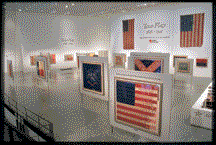 Launch
even a cursory study of the flags of Texas and you'll tap into the political,
cultural and aesthetic attitudes of the people who created the state.
It's a journey of war, intrigue, suspense and Hollywood-style endings.
And beginnings. Launch
even a cursory study of the flags of Texas and you'll tap into the political,
cultural and aesthetic attitudes of the people who created the state.
It's a journey of war, intrigue, suspense and Hollywood-style endings.
And beginnings.
Robert
Maberry Jr. '87 (MA) (PhD '92) began his own ascent into the banners'
colorful past when the United Daughters of the Confederacy asked him in
1999 to trace the history on 20 aging flags the organization had acquired.
Soon he was appointed historian for the Historic Flags of Texas Project,
where he met Peter Mario, director of the Museum of Fine Arts, Houston,
who was on the project's advisory board.
Marzio suggested
that Maberry place some UDC flags and some from the Texas State Library
collection in an MFAH exhibit in 2002. At least half of the ones that
Maberry picked had not been conserved, so the Friends of the Texas Historical
Commission agreed to raise the money to save the 15 or so historic flags
from destruction.
As he dug
into the flags' background, Maberry was first puzzled and then delighted
by the lack of information available. "It's an historian's dream to find
a subject people care about that's never had scholarly work done on it
before," he said. Texas Flags was born.
The book
has earned prestigious awards from the Texas Historical Commission, the
Texas Historical Foundation, the East Texas Historical Society and the
Texas State Historical Association. It ranks as one of Texas A&M Press'
all-time top-selling history books. Now 29 historic Texas flags will be
back on display in a two-year traveling exhibit sponsored by TCU's Center
for Texas Studies. The exhibit opened at the Bob Bullock State History
Museum in Austin on Feb. 28 and runs through Aug. 22.
It will grace
the El Paso Museum of Art from Sept. 12 through Jan. 9, 2005, and the
George Bush Presidential Library and Museum in College Station from Aug.
5, 2005, through Dec. 7, 2005. It will be in Fort Worth at the National
Cowgirl Museum and Hall of Fame from Dec. 29, 2005, until Feb. 12, 2006.
Texas
Flags is available at most bookstores. For more information, call 817-257-6295
or visit www.texasstudies.org.
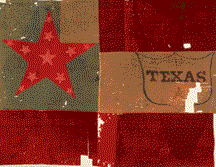 Sixth
Texas Cavalry Battalion/Gould's Battalion/Stars and Bars Variant, from
the Civil War, probably around 1862. This homespun variant of the
Confederate First National Flag displays no less than three different
Texas "lone" stars. Sixth
Texas Cavalry Battalion/Gould's Battalion/Stars and Bars Variant, from
the Civil War, probably around 1862. This homespun variant of the
Confederate First National Flag displays no less than three different
Texas "lone" stars.
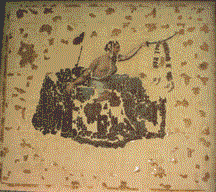 Sidney
Sherman's Company San Jacinto Battle Flag from the Texas Revolution, 1836.
Cincinnati artist James H. Beard painted this flag, which led Sam Houston's
Texian army at the Battle of San Jacinto. This is all that is left of
a wonderful work of art. Sidney
Sherman's Company San Jacinto Battle Flag from the Texas Revolution, 1836.
Cincinnati artist James H. Beard painted this flag, which led Sam Houston's
Texian army at the Battle of San Jacinto. This is all that is left of
a wonderful work of art.
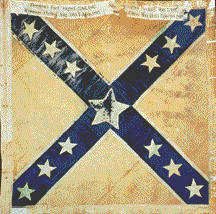 Fourth
Texas Infantry/Hood's Texas Brigade/Army of Northern Virginia Battle Flag/Silk
Pattern Variant/Wigfall Presentation Flag from the Civil War, 1861.
This flag led the Fourth Texas Infantry at the battles of Second Manassas
and Antietam before being sent home to be displayed in the state Capitol.
It was saved from capture as the war ended when Texas veterans buried
it outside Austin. Fourth
Texas Infantry/Hood's Texas Brigade/Army of Northern Virginia Battle Flag/Silk
Pattern Variant/Wigfall Presentation Flag from the Civil War, 1861.
This flag led the Fourth Texas Infantry at the battles of Second Manassas
and Antietam before being sent home to be displayed in the state Capitol.
It was saved from capture as the war ended when Texas veterans buried
it outside Austin.
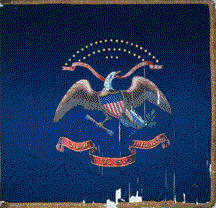 Twenty-fourth
U.S./Infantry/"Buffalo Soldiers"/Regimental Color from the West
Texas frontier in 1869. This African-American infantry regiment not
only battled hostile Indians but performed the harsh day-to-day tasks,
such as scouting, surveying, building roads and escorting wagon trains,
that made western settlement possible. Twenty-fourth
U.S./Infantry/"Buffalo Soldiers"/Regimental Color from the West
Texas frontier in 1869. This African-American infantry regiment not
only battled hostile Indians but performed the harsh day-to-day tasks,
such as scouting, surveying, building roads and escorting wagon trains,
that made western settlement possible.
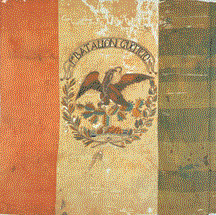 Guerrero
Battalion/Mexican Tricolor Battle Flag from the Texas Revolution, 1836.
This finely embroidered flag displays an elaborate version of the eagle
and snake national arms of Mexico. Guerrero
Battalion/Mexican Tricolor Battle Flag from the Texas Revolution, 1836.
This finely embroidered flag displays an elaborate version of the eagle
and snake national arms of Mexico.
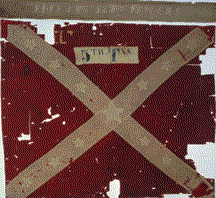 Fifth
Texas Infantry/Hood's Texas Brigade/Army of North Virginia Battle Flag
Variant/Mrs. Young Flag from the Civil War, 1862. Houston educator
and philanthropist Maude Young gave this flag to the regiment. It was
present at the famous "General Lee to the rear" episode during
the Battle of the Wilderness. Fifth
Texas Infantry/Hood's Texas Brigade/Army of North Virginia Battle Flag
Variant/Mrs. Young Flag from the Civil War, 1862. Houston educator
and philanthropist Maude Young gave this flag to the regiment. It was
present at the famous "General Lee to the rear" episode during
the Battle of the Wilderness.
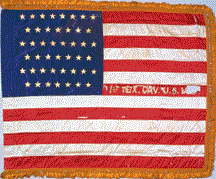 First
Texas Cavalry/U.S. Volunteers/National Color from the Spanish-American
War, 1898. After Congress declared war against Spain following the
destruction of the battleship Maine in Havana, Texans flocked to the colors.
The Stars and Stripes of the First Texas Cavalry, an all-volunteer regiment,
is testament to their enthusiasm. First
Texas Cavalry/U.S. Volunteers/National Color from the Spanish-American
War, 1898. After Congress declared war against Spain following the
destruction of the battleship Maine in Havana, Texans flocked to the colors.
The Stars and Stripes of the First Texas Cavalry, an all-volunteer regiment,
is testament to their enthusiasm.
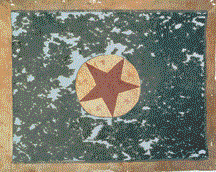 Sixth
Texas Infantry and Fifteenth Texas Calvary (consolidated)/Granbury's Texas
Brigade/Hardee Battle Flag from the Civil War, 1864. Texas troops,
whenever possible, embellished their flags with a representation of the
Lone Star, as seen on on this well-worn regimental color. Sixth
Texas Infantry and Fifteenth Texas Calvary (consolidated)/Granbury's Texas
Brigade/Hardee Battle Flag from the Civil War, 1864. Texas troops,
whenever possible, embellished their flags with a representation of the
Lone Star, as seen on on this well-worn regimental color.
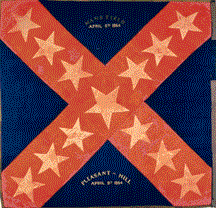 Unidentified
Texas Unit/Taylor Battle Flag, possibly from the Civil War, 1865.
This style is named for Gen. Richard Taylor, who commanded Texas troops
in Louisiana, and reversed the colors of the most famous Confederate battle
flag. Unidentified
Texas Unit/Taylor Battle Flag, possibly from the Civil War, 1865.
This style is named for Gen. Richard Taylor, who commanded Texas troops
in Louisiana, and reversed the colors of the most famous Confederate battle
flag.
 Twentieth
Texas Infantry/Stars and Bars Variant from the Civil War, 1861. This
spectacular First Confederate National Flag was made in Galveston and
originally displayed a painting on the center strip. Twentieth
Texas Infantry/Stars and Bars Variant from the Civil War, 1861. This
spectacular First Confederate National Flag was made in Galveston and
originally displayed a painting on the center strip.
Robert
Maberry Jr. '87 (MA) (PhD '92) was the historian for the Texas Historical
Commission's Historic Flags of Texas Project. He curated the Texas Flags
exhibit at the Museum of Fine Arts, Houston in 2002 and authored Texas
Flags, published by Texas A&M Press in association with the MFAH.
Maberry,
an adjunct history faculty member at TCU, is on the steering committee
for TCU's Center for Texas Studies. He also serves on the boards of the
Grady McWhiney Foundation and the Texas Historical Foundation. He has
a full-time dental practice in Lake Worth and lives in Fort Worth with
his wife, Anita.
Top
|



